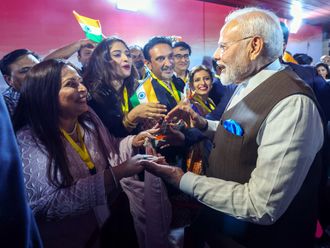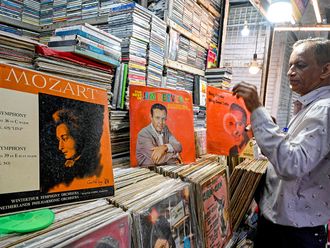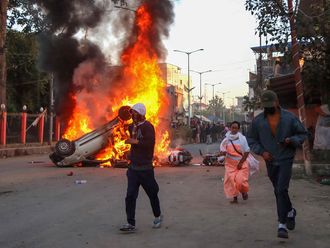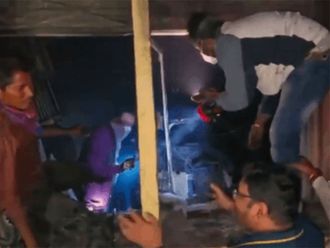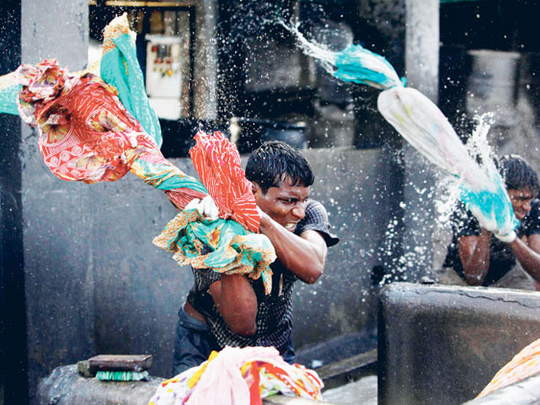
Amid the bustle of congested roads, busy shopping malls and hectic call centres, for those who wash clothes for a living at Dhobi Ghat, India's traditional laundry stalls, time follows a more leisurely rhythm. Grizzled Ram Swarup sits under a tree in the 110-degree heat, folding towels. "I'm around 60," he says.
Exact dates aren't all that important here at Dhobi Ghat No 28 on Deendayal Upadhyay Road. A few feet away, muscular young dhobis, or washermen, beat white shirts against concrete slabs, mirroring their ancestors of centuries past, just as Swarup did until his body gave out. Years spent knee-deep in bleach, starch and indigo water take their toll.
A colonial legacy
The British built this tangle of concrete pools near Connaught Place in 1932, reportedly to avoid having their laundry battered and muddied in the nearby Yamuna River.
He likes to grab my nicest shirts/And pound them on a stone, reads a poem titled Our Dhobi written around that time by F. Mowbray Velte, a professor of English literature living in India. Reducing every button/To shattered bits of bone.
In the next pool, dhobi Pritam Lal, who reckons he is closer to 70 than 60, recalls how fastidious the English were — especially about the ironing. They loved their starch, a gluey paste made from boiled tapioca and often had their apparel pressed two or three times, especially the pleats their women wore. "Clothes are clothes," Lal said. "But those were difficult."
For a time, the Indian army aped the colonial masters in the love of starch after independence in 1947, until reason prevailed, the dhobis said, noting that starched clothing is very uncomfortable in India's often-extreme heat.
Although the British have their share of critics in India, most dhobis — starch aside — are not among them.
The former imperialists built bungalows and servants' quarters for their launderers, housing since taken away under Indian rule through trickery, political muscle and bulldozers, they said.
That has left most of the 135 families in New Delhi squatting under flimsy sheets of tin and tarp. "The British were better than our government," said dhobi K.C. Singh. "At least they didn't harass us."
While much of the world defined the 1960s by race riots, war and social turmoil, the dhobis recall it as a time when Indian cottons prevailed until their sudsy tanks started filling up with Terylene, a British precursor to Dacron.
Polyesters were fine, dhobis said, although they sometimes caught fire when sparks jumped from the coal-heated irons. Their colours also bled a bit more, until the colour-fast blends came through.
Regional conflicts such as the 1965 and 1971 India-Pakistan wars are remembered at the ghat for having driven up the price of washing powder and forcing dhobis to dig civil defence trenches.
At the time, diving for cover during air-raid exercises meant soiling the dhobis' own clothes. A strange new apparel appeared in the mid-1970s, a fashion item said to be inflicted on society by some unthinking Bollywood director.
"I never owned a pair of bell-bottoms," said Swarup, his skin hanging loosely on his bony frame. "Actually, I found them a bit strange-looking. They had more fabric but we weren't paid any more to wash them."
On occasion, though, additional fabric has been a boon, most notably a decade later, when middle-class Indians started using top sheets, doubling that business overnight.
After the ugly and the good came the bad, however — the unwelcome blue-jean rage, Swarup said. Denim is a heavy fabric when wet, he noted, and the blue-jean crowd really let the grime sink in before washing.
The true existential crisis in the dhobi world, however, has been the advent of home washing machines. An Associated Press article in 1969 heralded the change: "Many middle-class families in India are throwing off ancient taboos against ‘respectable' people doing menial work and the housewives are doing their own laundry and ironing."
"We hate home washing machines," Lal said. Not that technology has been all bad. The arrival of streetlights around 1985 and electrification of the ghat in 1998 allowed ambitious dhobi families to buy industrial washing machines.
Initially, some feared the machines would tear up clothing, explode or otherwise destroy their world. But in a nation where public laundromats are unheard of, most of the dhobis adapted, replacing the household work with hotel and restaurant work that may pay only 5 cents per napkin but involves higher volumes. An average dhobi family, with everyone pitching in, earns about $250 a month.
Most dhobis, estimated by the Delhi Dhobi Welfare Committee at six million nationwide, toil in obscurity. The community has thrown up its occasional hero, however, including Ram Chander, who, in 1947, received India's second-highest gallantry award for rescuing an officer and battling insurgents in Kashmir, and humanitarian Gadge Baba (1876-1956), regarded by many as a saint.
Affected by change
India's changing social fabric has also affected the ghat. For centuries, it was your fate to be born a dhobi, considered part of the Dalit, or untouchable, caste, given the work with dirty sheets and other impurities. Nowadays, it is easier to marry or work outside the community, although many social barriers remain, said Subhadra Channa, a sociologist at the University of Delhi.
"Before electricity came in 1998, decades passed without much change. You could sit and chat without fear in your mind," said Sanjay Kumar, 38, at nearby Lodi Garden ghat. "Now everyone wants things so fast. There's stress, bills, fear they'll take your land away. Life just seems to be getting less and less secure."


